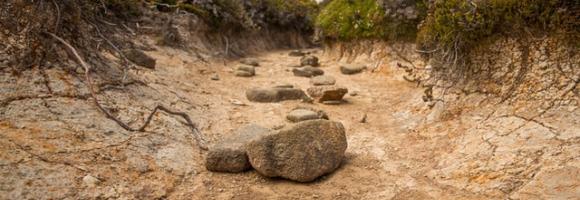
Indicator units: Natural (and semi-natural) land fragmentation refers to the reduction of area, the emergence of discontinuities and the isolation of natural land patches within a region of interest. Natural land spatial pattern is a relevant measure to capture changes in size, shape and structural connectivity, in particular the breaking down of large patches of natural land into smaller patches, the presence of linear features and isolated small fragments. The Natural Land Pattern Index (NLPI) assesses the spatial pattern of the natural and semi-natural lands for a given year (here, at year 2015) by reporting the area (in km2) covered by six spatial pattern classes (core, edge, linear feature, islet, core-perforation, other non-natural land) within a region of interest. The Natural Land Pattern Dynamics (NLPD) index reports the trends in the area occupied by these pattern classes in the last 20 years (1995-2015) within a region of interest. The landscape mosaic is simplified into natural/semi-natural lands, water bodies and non-natural lands. Non-natural lands such as cropland, transport infrastructure and settlements, are considered fragmenting elements.The six pattern classes are determined based on the spatial arrangement, shape and size of the land cover patches; See below (Use and Interpretation section) for a detailed description of these six classes. Fragmentation can be further resumed in one single indicator value, such as the edge to core ratio. The Natural Land Fragmentation Index (NLFI) and the Natural Land Fragmentation Dynamics (NLFD) will be included in the next update of the DOPA.
Area of interest: NLPI and NLPD are calculated in DOPA for each terrestrial and coastal protected area, as well as for countries and terrestrial ecoregions, and are provided in DOPA Explorer for all terrestrial and coastal protected areas of size ≥ 1 km2 , for countries and for terrestrial ecoregions. The spatial distribution of the six pattern classes is mapped and shown in DOPA for all natural/semi-natural land, either inside or outside protected areas.
Policy question: How can we assess the spatial integrity of natural/semi-natural ecosystems?
Where and how much are global and local pressures fragmenting natural/semi-natural lands? Pressures on the natural land, particularly
human driven pressures, are constantly increasing and it is important to monitor how they translate in changes in the spatial pattern and
fragmentation levels of natural/semi-natural ecosystems, in particular inside and around protected areas, to ensure that these ecosystems, and their associated species, their functions and services, are preserved.
___
Data Uploaded by Luca Battistella using the Digital Observatory for Protected Areas Services (2022)
Land Fragmentation
The Natural Land Pattern Index (NLPI) values and their trends (NLPD) allow evaluating the status and dynamics of fragmentation processes in terms of few key relevant spatial pattern changes in protected areas and in their buffer areas. Six landscape pattern classes have been determined, based on the land cover information of the Climate Change Initiative Land Cover (CCI-LC) map, using an edge width of 300 m (corresponding to one pixel in the CCI-LC map at the equator).
The six pattern classes, which are exemplified in Figure 1, are the following:
NATURAL LAND
- Core: Area of natural/semi-natural land cover that is not adjacent to non-natural land cover, i.e. that is separated by a distance larger than the considered edge width (300 m in the equator) from non-natural land covers.
- Edge: Area of natural/semi-natural land that surrounds the core areas and that is adjacent to non natural land cover.
- Islet: A patch of natural/semi-natural land cover that is too small to contain any core area (all the extent of the patch is closer to nonnatural land cover than the considered edge width).
- Linear feature: All other areas of non-core natural/semi-natural land that do not fall into any of the two non-core classes above. It typically corresponds to small and elongated extents of natural/semi-natural land that extend from outside the edge of a core patch, either connecting or not to another core patch.
NON NATURAL LAND
- Core-perforation: Non-natural land fully enclosed by core area. It corresponds to the non-natural land found within openings of natural/semi-natural land due to anthropogenic (e.g. settlements, shifting cultivation) processes.
- Other non-natural: other areas not falling in any of the previous categories: it includes non-natural areas (cropland, urban) as well as water bodies.
Land Fragmentation
The Natural Land Pattern Index (NLPI) values and their trends (NLPD) allow evaluating the status and dynamics of fragmentation processes in terms of few key relevant spatial pattern changes in protected areas and in their buffer areas. Six landscape pattern classes have been determined, based on the land cover information of the Climate Change Initiative Land Cover (CCI-LC) map, using an edge width of 300 m (corresponding to one pixel in the CCI-LC map at the equator).
The six pattern classes, which are exemplified in Figure 1, are the following:
NATURAL LAND
- Core: Area of natural/semi-natural land cover that is not adjacent to non-natural land cover, i.e. that is separated by a distance larger than the considered edge width (300 m in the equator) from non-natural land covers.
- Edge: Area of natural/semi-natural land that surrounds the core areas and that is adjacent to non natural land cover.
- Islet: A patch of natural/semi-natural land cover that is too small to contain any core area (all the extent of the patch is closer to nonnatural land cover than the considered edge width).
- Linear feature: All other areas of non-core natural/semi-natural land that do not fall into any of the two non-core classes above. It typically corresponds to small and elongated extents of natural/semi-natural land that extend from outside the edge of a core patch, either connecting or not to another core patch.
NON NATURAL LAND
- Core-perforation: Non-natural land fully enclosed by core area. It corresponds to the non-natural land found within openings of natural/semi-natural land due to anthropogenic (e.g. settlements, shifting cultivation) processes.
- Other non-natural: other areas not falling in any of the previous categories: it includes non-natural areas (cropland, urban) as well as water bodies.